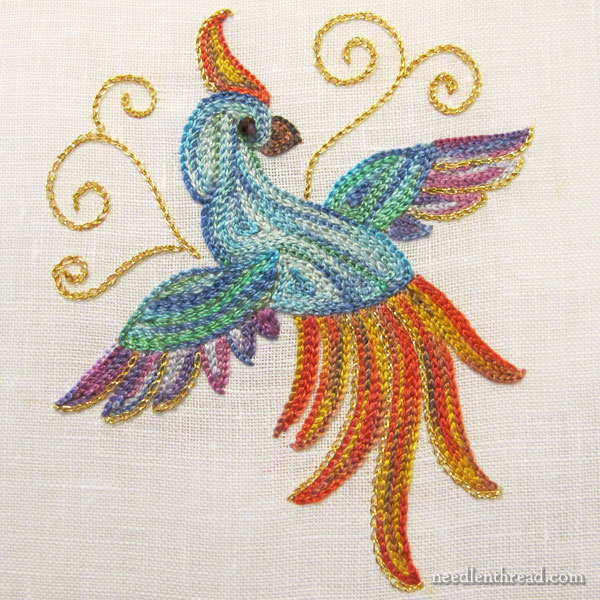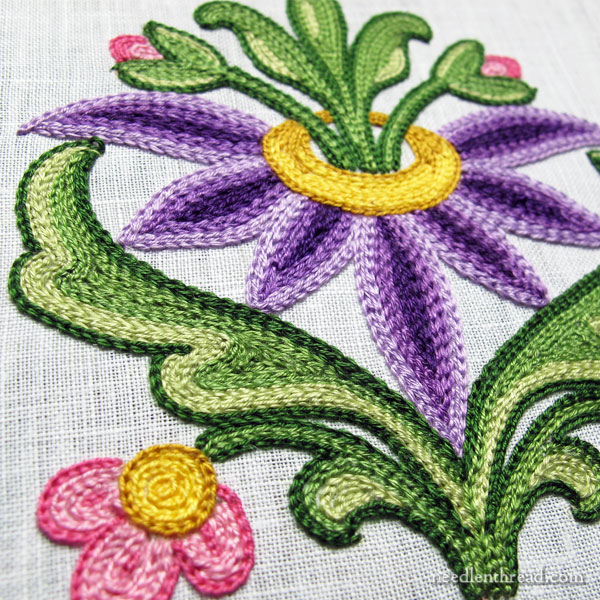It’s been about 10.5 years since we’ve explored tambour embroidery here on Needle ‘n Thread. I’ve brought it up now and then, but we haven’t looked at it in-depth in a long, long time.
Shortly, I’m going to bring up the topic again in a little more depth, but for those who are new to Needle ‘n Thread (and I use the term “new” pretty loosely!), I thought I’d touch on tambour embroidery and give you a little background before it comes up again, seemingly out of the blue. That way, you’re not wondering what the heck I’m talking about or scurrying around to find out!
And it will also allow me to be a little less wordy (and I use the term “less” pretty loosely!) when the time comes.

Tambour embroidery is essentially hand embroidery that’s done with a special tool (as in, not a needle, but a hook) and that results in a chain stitch.
Tambour work is not to be confused with punch needle embroidery, which doesn’t involve a hook, and results in loops standing up from the fabric kind of like carpet.
Tambour work is not restricted solely to chain stitch embroidery, but the chain stitch is the common stitch that comes forth from the tambour needle. The stitch and techniques can be manipulated in a number of ways to produce different results, but overall, the chain stitch in some form is The Thing that Happens with a tambour hook.
Tambour work is seen predominantly these days in the couture industry, as it used for beading on sumptuous gowns and other wearable art.
But it’s not limited to the world of haute couture. It can actually be a useful technique in any stitcher’s embroidery arsenal.

One advantage of tambour work is that, though not machine-done, it is pretty darned fast – it works up much faster than the typical needle-and-thread embroidery approach with chain stitch. Once you get the hang of the technique, you can move along at a jolly clip and create intricate borders, filled designs, and more with a tambour needle.
Another advantage is that it’s really fun! I find tambour work extremely relaxing. It’s somewhat like a combination of embroidery and crochet in its almost-mesmerizing, methodical repetition.
Now, that might sound boring – “mesmerizing, methodical repetition” – but in fact, that type of work can be extremely soothing, calming, healing, and quite satisfying – especially since you see results pretty quickly.
If you have not explored tambour work before, you can start your explorations here, in this Tambour Embroidery Index. You’ll find the basics of tambour work, some early explorations, a couple projects I’ve done, and tips and techniques.
For those who just want to see how it’s done, you can go straight to this how-to video that demonstrates the basic technique used for tambour work.
To prepare for the topic of tambour embroidery, I brought in some tambour sets (the handle with three stainless steel hooks in the common sizes) that are available here in the Needle ‘n Thread shop. If you want to practice tambour work and see if it’s for you, these are great sets for beginners and beyond.
We will delve more into tambour work in the near future. I have a book to show you and a project that I’m eager to get underway!
In the meantime, feel free to explore the topic!







I’ve been reading your e-newsletters for several years and vaguely remember some of the previous pieces you’ve written about tambour embroidery whilst exploring your website. I’m embarrassed to confess I remember thinking it wasn’t a technique I would ever find appealing. Until today:) Thank-you for the revisit, it has so sparked an interest in me now that I’ve just ordered the inexpensive set of equipment (tools and stand) I could find quickly here in the UK (I live in NE Scotland). If the price conscious equipment is sufficiently robust enough to get me through the learning process, I will invest in better equipment. Thank-you again for the revisit, and thank-you for all you do for needlework.
Woo-hoo! I have recently become extremely interested in tambour work via some beading and sequin work I found, but I didn’t make the connection that it must be connected to embroidery. I just bought a tambour needle from your shop when I ordered my wool flowers kit (noticed it by accident) and I’m thrilled you will be delving into it soon. Now I’m on my way to check out your previous posts about it. Thank you!
Hi Mary,
Any suggestions on where to order Coton a broder 25 (DMC Art. 107) threads?
Thank you…Susan
You can find them at Needle in a Haystack (www.needlestack.com) and Lacis (www.lacis.com).
Thanks so much for bringing this topic — and especially for the video. I’ve tried to do chain embroidery as part of my needlepoint (curved lines with more substance that packed outline or stem stitch and less fiddly than couching) and was getting frustrated. I’ve got fine crochet hooks, but it was the video that clued me in to the manipulation of the hook direction that may make the difference. I’m going to take a look at the sus.pplies/equipment and see what I can add to my tool kit–and address a couple of WIP
It was tambour embroidery which first brought me to your website! I had a dream – which later turned into a fantasy novel – in which one of the characters was doing tambour work, which I knew next to nothing about. I searched for what I could find online that wasn’t beading-related, and yours was one of the more helpful sites I found.
The novel – Amiant Soul – just came out this last March. Lady Laotice does a lot of tambour work (or “puncta” as it is called in her world), including in a howdah on the back of a camel, and her work has magical powers…
Oh! I will have to look that up, Deborah! Congratulations!!
Can tambour embroidery be used on dish towels? It looks like a good embroidery technique for the Scroll Towel Set.
Yes! I have done towels with tambour work, both on cotton and on linen.